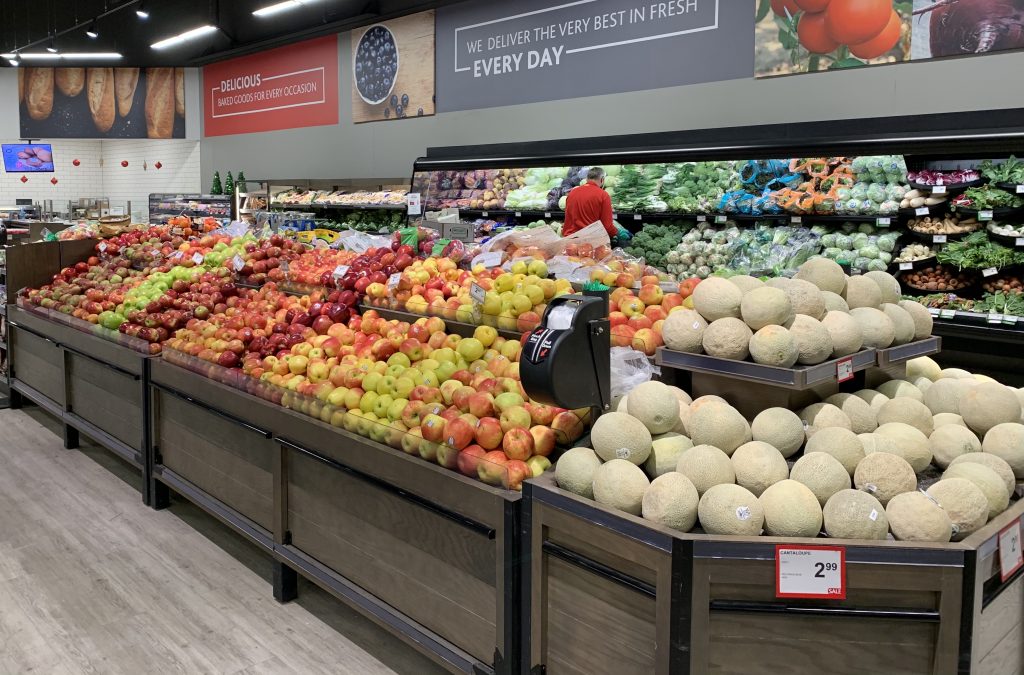
In Canada, there is a wide variety of large and small grocery store options to purchase food. From Real Canadian Superstores and No Frills to community grocery stores and food co-ops, there are many stores to choose from and considerations to make in deciding where to shop.
Learning more about the grocery stores available to you will help you to find a store that will fit your unique needs and budget. If you have multiple options, it is generally more convenient for shoppers to choose one main store in which to buy most of their groceries. Click here for the Types of Stores that Sell Food.
Factors to consider when deciding where to shop include:
- Location and Transportation
● What is the distance to the closest store from your home?
● Do you have a license and access to a vehicle? If not, can you carpool with a neighbour or family member? Is it feasible to take a bus or taxi?
● For rural and northern families, is there only one store available in your community? - Grocery Selection
● Can you get most of your needed groceries in one store?
● Do they offer a good selection of fresh, healthy food products?
● Do you require any specialty items that will require a second trip to another type of grocery store? - Grocery Prices
● How do prices compare to other grocery stores?
● Do they offer a “price match” guarantee so you can always get the lowest price?
● Are there specific days when extra savings are offered at checkout like senior’s day discount or student discount? - Store Hours and Facilities
● Is the store open at times when you want to buy food?
● Are there parking facilities and any other special accessibility services that you require? - Shopping Services / Benefits
● Does the store offer convenient options like home delivery or curbside pick-up options? What are the fees attached to these services?
● What in-store points programs or rewards are there for shopping or becoming a store member?
Grocery Delivery Tip: Instacart is a new online shopping option that is available in many large grocery stores. They will deliver to many areas within major cities however consumers should be aware there are fees attached to this service. Food prices are marked up higher than in-store prices and any in-store discounts are not applied to your order. The service is very convenient, but these costs can add up to significantly more money spent on groceries. See the Instacart website for terms set by each retailer.
Before You Shop: Plan Ahead
Being organized before you head to the store will help you shop efficiently.
- Create a grocery list. Using the menu plan for the week, create a list to take to the store. Read more in Menu Planning.
TIP: To avoid buying things you already have, take inventory of your fridge, freezer and pantry. This will help to avoid food waste and will prevent buying things you do not need for the week. If you are trying to spend less, be flexible in your ingredients and try to substitute some items for things you already have on hand. If you are on a tight budget, you may want to estimate the food costs by using prices from previous receipts or by using store flyers. Adjustments can be made to include less expensive foods if you need to reduce the amount spent. Read Planning Meals on a Budget for more ideas. - To save time when shopping, group items on your grocery list according to the different food groups and sections within the grocery store. You are also less likely to miss items on the list when they are grouped this way. Click here for a blank printable grocery list.
- Check flyers to see if any of your listed food items are on sale or if there are valid coupons available. Some stores have coupons located at the front of the store as well as placed throughout the store among products.
- Pack your reusable shopping bags. If you have insulated reusable bags, they are good for keeping foods either hot or cold as you transport them home.
At the Store: Shopping Tips
- General plan for shopping is non-perishable food first, followed by fresh produce, then refrigerated and frozen food items last. This ensures the cold and frozen foods spend as little time as possible in your cart.
- Shopping the centre of the store first will put heavier boxed/canned goods, drinks and non-food items in the bottom of the cart. The fresh produce, meats, dairy and bakery items are usually located around the perimeter of the store (against the back and sides). Spend most of your shopping time in this fresh food area.
- Compare the prices of different brands. Products on shelves above or below eye level may sell for less as the most popular brands get preferred eye level shelf space.
- Try no name or store brand items. The food is often produced by the same manufacturer and they are usually cheaper. Read Save Money at the Grocery Store for more ideas.
- Compare unit prices when choosing which size is the best buy. Larger packages are not always the best value, especially if the small package is on sale. Read more on how to compare prices in the article Comparing Prices and Promotions.
- Read “Best Before” and expiry dates and always choose the product with the date farthest away – usually at the back of the shelf. For more information on package dates, read Understanding Food Labels.
- Check the quality of the food you buy. Check eggs for cracks, check that cans have no dents, rust or bulges, and check that packaging on any frozen foods or meat is undamaged.
- If you are unfamiliar with where something is located within the store, ask employees for help. They are there to assist customers.
- When checking out, watch the cashier screen as the items are scanned to ensure mistakes, like an item ringing in twice or a sale price not coming up do not occur. If you think a mistake has been made, let the cashier know.
- If you change your mind in the checkout line about buying a product, inform the cashier and hand them the item you no longer want. The cashier will place the item aside and have it put back on the shelves.
After you Shop: at home
- Unpack your groceries as soon as you get home. Refrigerated and frozen items need to be put away as soon as possible to maintain quality. Read more in Food Safety.
- Read over the store receipt to check for errors. For an explanation of the information, see Reading a Grocery Store Receipt. If you are tracking your spending using receipts, put your receipt in the designated spot.
Buyer Beware: Understanding store selling strategies
There are a few things stores do to attract customers and get them to buy more. Being aware of these strategies will help you resist their temptations and stick to your shopping list.
Advertising and loss leaders. Grocery flyers and ads with specials are appealing and draw customers to the store. Sometimes a store will advertise one product at a very reduced cost. This is called a loss leader and means the price is so low that the store does not make any money on that item. The idea is that the special low price brings customers to the store and they will spend enough on other products to more than make up for that cost.
Store layout. Stores are designed to encourage people to buy. Bread, eggs and milk, three of the main items people stop by to pick up between regular shopping trips, are usually in the back of the store. This means customers will have to walk past many other displays to get to the food they want. Chances are they will pick up a few unplanned purchases on the way.
Food Sampling. Retailers know that offering customers free food both increases sales and customer loyalty. Sampling is a great way to try new products, but beware the temptation to buy items you normally wouldn’t buy. Customers often purchase more after sampling both because eating food actually increases your appetite for more and subconsciously you feel obligated to buy the item after taking a free sample.
Cross merchandising. This type of display sets up two related items together, generally one high profit item next to a low profit, sale item. For example, next to the meat that is on for a special price might be a display of barbeque sauces and marinades.
Coupons and quantity discounts. There are often item specific coupons placed around the store to attract attention to a product and tempt consumers to add to their shopping carts. Another store strategy is to line shelves with signage offering a special price with buying in multiples (for example 2 for $5.00). Often the item will still be sold at the lower sale price even if only one is purchased (in this case, 1 for $2.50), and the store is simply trying to get you to buy higher quantities. The store signage is confusing and implies you need to buy more than one to get the special price. Each store has a different pricing strategy, so ask a store associate if you want to clarify a price.
Impulse items at checkout. Magazines and candy displays at the checkout are there to tempt you. Every customer has to pass by them and even stand in front of them while waiting to check out, so they are an easy way to tempt customers to pick up extra items.
Read these articles next:
Save Money at the Grocery Store
Safe Food Storage






